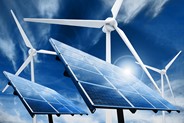
In today’s world, electricity touches almost every aspect of our lives. We know the basics of how OPPD delivers electricity to our homes, but have you ever wondered how that electricity is generated in the OPPD service area?
As you may know, the landscape of power generation is changing. Utilities, including OPPD, are moving farther away from fossil fuels, and shifting focus to cleaner, renewable sources of energy. As part of the Power with Purpose (PwP) initiative, OPPD is also working to diversify our energy portfolio in order to help improve the resiliency of the power grid and serve the growing community. While working to lay the groundwork needed to support new, cleaner power sources, OPPD will rely on existing baseload plants and balancing plants to continue to provide the reliable energy that OPPD customers have always experienced.
Low-Sulfur Coal – Keeping Us Going
Coal-powered generating facilities are a part of the OPPD service area and function as baseload plants. A baseload plant is a power station that provides a continuous supply of electricity throughout the year. While we are looking to convert power stations from low-sulfur coal to natural gas to move towards cleaner energy, coal-powered plants are still an integral part of OPPD’s energy portfolio. Coal-fired power plants burn highly flammable, powdered coal to heat water in a boiler to create steam. This pressurized steam then drives a generator and creates electricity. These baseload plants provide stable and reliable power to the grid while we work toward incorporating more renewable power sources. To make the most out of our coal-powered facilities, the coal fly ash that is produced can be sold and repurposed in a variety of ways, including concrete production.
Natural Gas - Backing Up Our Future
Natural gas is another important part of OPPD’s PwP initiative. Natural gas is a cleaner and more efficient power source than coal. And when paired with renewable sources of energy, it allows OPPD to guarantee a supply of power to meet the generation and capacity requirements of peak energy demand. These bolster the power grid by supplying a dependable and consistent amount of energy to balance variable renewable generation and backup the baseload plants.
There are two types of technology used by OPPD to convert natural gas into energy:
![]() Reciprocating Internal Combustion Engine (RICE)
Reciprocating Internal Combustion Engine (RICE) ![]() Simple-Cycle Combustion Turbine (CT)
Simple-Cycle Combustion Turbine (CT)
OPPD’s facilities use a combination of RICE and Simple-Cycle CT’s. Both have fast startup performance,
can operate at a reduced load, generate lower emissions, and are capable of quickly providing power.
RICE technology utilizes internal combustion engines, similar to a car engine, to convert natural gas into energy to drive a generator, which produces electricity. It has the fastest ramp rate (the speed at which a generator can increase generation), puts out the lowest amount of heat, and has a high operating efficiency. While this technology has higher installation costs, it provides the greatest return on investment in terms of supporting ever-changing load needs.
Simple-Cycle CT's utilize a combustion turbine similar to airplanes. The natural gas is combusted in the turbine which drives a generator to produce electricity. They have a fast ramp rate, but their efficiency decreases slightly when they operate at reduced loads. The major benefits of this technology include lower maintenance costs and a smaller physical footprint with higher power outputs.
The new Turtle Creek station includes two Simple-Cycle CT's while the new Standing Bear Lake station will use RICE technology. Both stations are being built as part of OPPD’s PwP initiative and are planned to be complete and energized by 2026. These stations are anticipated to run up to 15% of the time as more renewable energy is integrated into the OPPD grid.
Renewables - Filling Out Our Portfolio
Solar Power - A Bright Source of Energy
Solar power is harnessed and converted into electricity through the use of solar panels. Solar panels are made up of many small components called photovoltaic cells, which convert sunlight to energy by allowing particles of light to remove electrons from atoms.
Solar generation is beneficial in many ways, when compared to coal generation. Not only is solar energy a cleaner, renewable source of energy, but solar generation facilities are five times cheaper to construct than new coal generation. Additionally, coal requires ongoing fuel costs that solar facilities don’t have.
A common concern with solar generation is whether the weather will cooperate enough to generate an adequate amount of power. Not only do advancements in solar technology allow better optimization of the amount of sunlight that is captured each day, but Nebraska is actually ranked 13th in country for solar energy potential.
Wind Power - Breezy Energy
OPPD has purchase power agreements with several wind farms across the entire state of Nebraska. Wind farms utilize wind turbines to generate power. As the wind turns the blades of the turbine, a gearbox powers a generator.
Land Fill Gas - Finding the Light in our Trash
OPPD also utilizes landfill gas as a source of renewable energy. The Elk City Station, located near the Douglas County landfill, went online in 2022. It contains 108 extraction wells that provide methane and carbon dioxide gas to generate electricity. As the trash at the landfill decomposes, methane and carbon dioxide are produced. Extraction wells at the landfill collect and deliver the gas to a central collection station where the gas is converted into electricity by combustion engines.
For more information on the types of fuel sources OPPD currently uses for generation, check our Energy Portfolio page.


 Learn More!
Learn More!